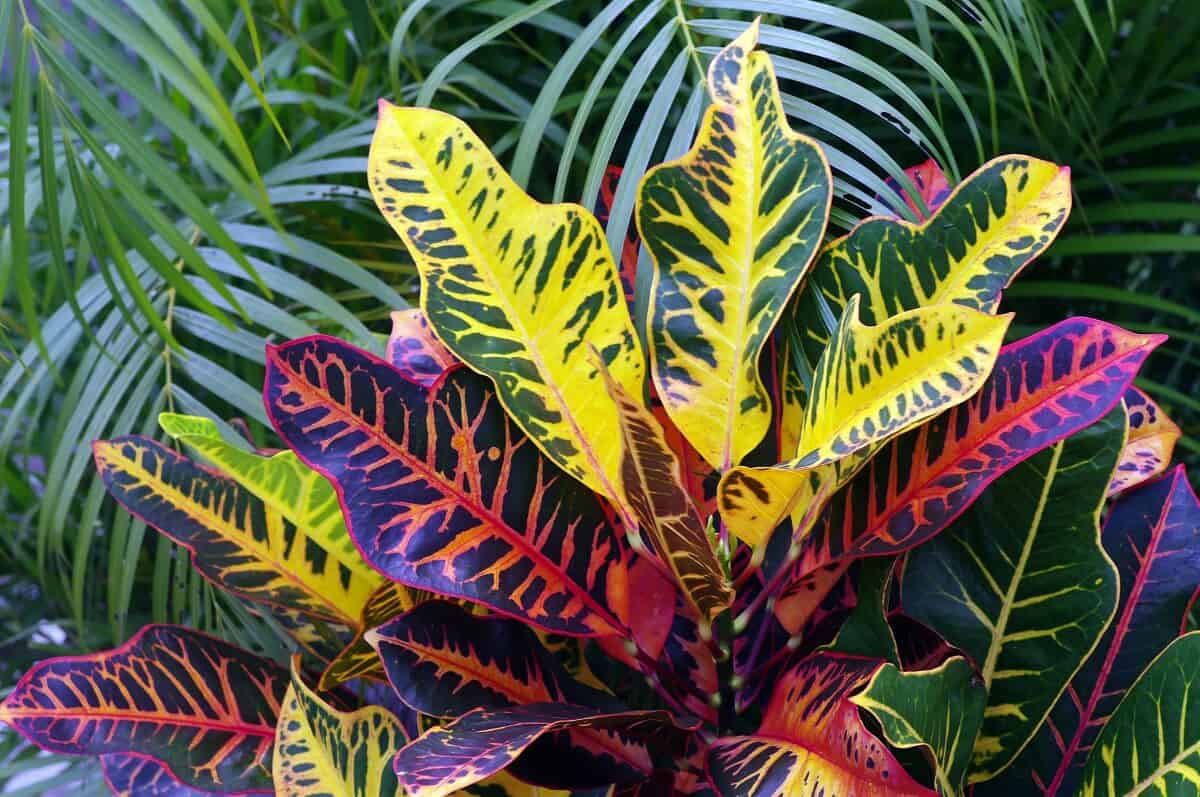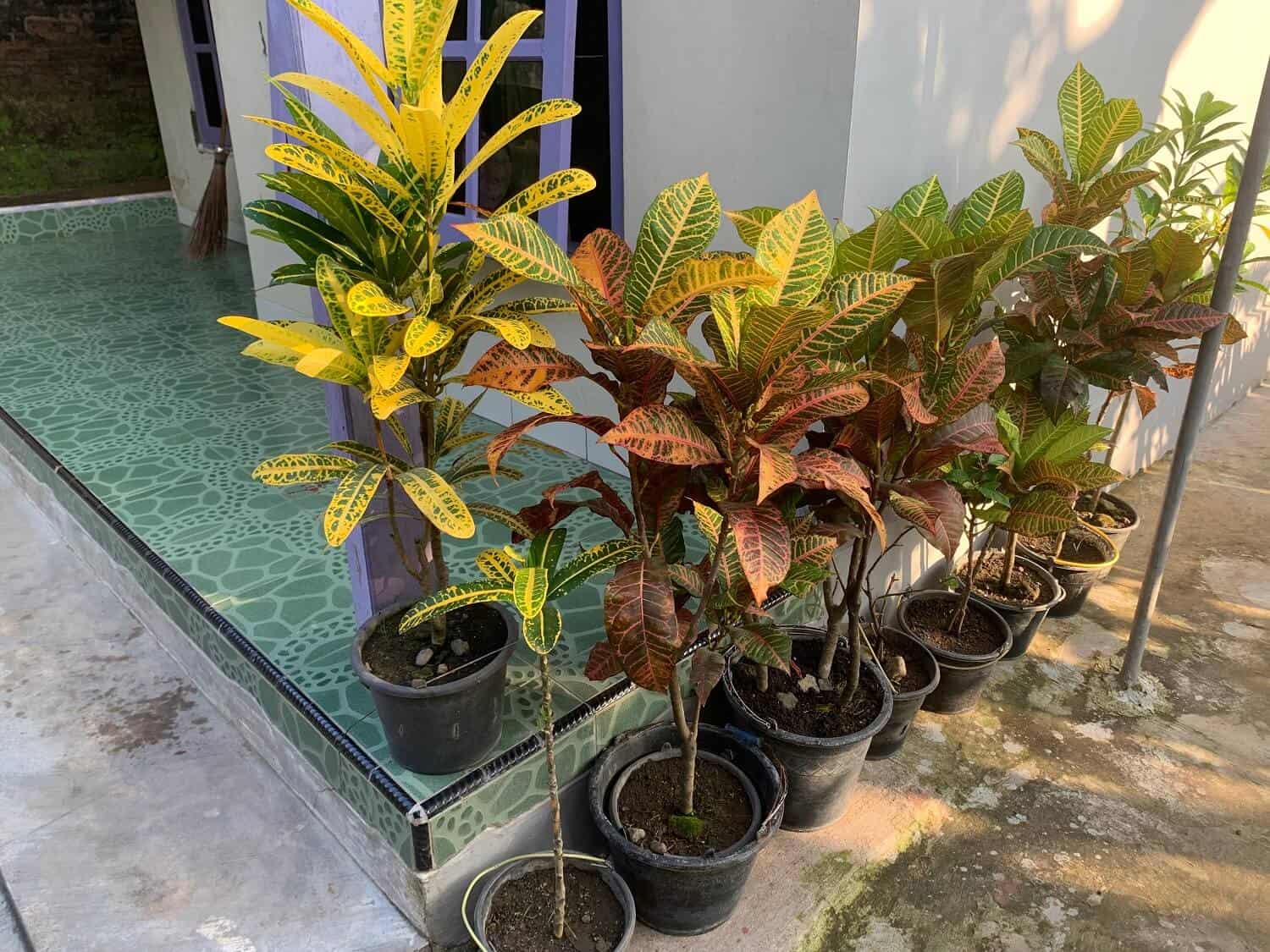Croton is an evergreen shrub or small tree with broad, vividly colored leaves that can bring a Tropical flair to any landscape or indoor space. With more than 100 croton varieties, there's something for everyone in terms of color combination.
Some are rare and difficult to come by while other cultivars are often available and just as striking.
Hence, in today's post, we'll focus on the most popular and commonly available varieties.
If this gets your interest, then read on:
Background Information on Crotons
Botanically known as Codiaeum variegatum, Croton is a member of the euphorbia family. It's native to tropical Asia and the western Pacific region.
This striking plant varies widely in leaf color and pattern and numerous cultivars have been developed.
Most of these cultivars are hardy in zones 11 and 12. In the native settings, they can grow up to 10 feet tall contrary to when you grow them indoors - where they're much smaller but still vibrant.
On the downside, the milky sap produced by this plant can cause contact dermatitis if it touches your skin. It's a common phenomenon for all plants in the Euphorbiaceae family.
Therefore take caution when handling croton plants.
13 Best Croton Varieties to Grow in Pots Indoors
Cascading Dreadlocks Croton
If you're looking for a show-stopping croton variety, then dreadlock it is! Developed by Emerald Goddess Gardens, the cascading dreadlock croton (Codiaeum variegatum ‘Dreadlocks’) has long, linear, ruffled leaves that taper slightly at the rounded ends.
This is a really unique and interesting croton, and a great choice for a show-stopping focal point, but a very slow-growing cultivar as compared to other crotons.
It grows moderately large, and will eventually mature at around 3 to 4 feet.
The new growth emerges green, then changes to bright yellow, followed by a bronze burgundy green tone, with paint-splattered speckles of yellow, peach, red, and orange appearing as the leaf ages.
Zanzibar Croton
The Zanzibar croton (Codiaeum variegatum ‘Zanzibar') is characterized by its narrow, cascading glossy leaves that are yellow, red, orange, and/or green in color.
The leaves' color will vary depending on the season and the amount of light the plant is getting. Therefore, don't be alarmed if you see the plant moderately changing its color.
It prefers warm, humid climates with plenty of sunshine.
Lauren’s Rainbow Croton
The Lauren’s Rainbow croton (Codiaeum variegatum ‘Lauren’s Rainbow') is a striking variety with beautiful, deep purple, green, and yellow striped leaves.
This type can reach 4-5 feet tall with a similar spread and is famous as an indoor plant due to its low maintenance needs. In order for the foliage colors to stay vibrant, this variety requires 6 hours of full sun exposure daily.
Iceton Croton
The Iceton croton (Codiaeum variegatum ‘Iceton') is a gorgeous variety with stripes of bright yellow foliage and deep green.
This particular type will reach heights of up to 4-5 feet tall at maturity and is an excellent choice for both indoor and outdoor plantings.
Iceton prefers more shade than some of the other varieties but should receive at least 3-4 hours of direct sunlight per day for optimal growth conditions. However, if the light is too low, it will lose most of its yellow variegation.
Banana Croton
As the name suggests, the banana croton (Codiaeum variegatum ‘Banana’) has banana-shaped leaves which are yellow-green like a ripening banana. With such unique traits, their popularity is on the rise.
At maturity, the cultivar can reach up to 8 feet tall when grown outdoors or 6 feet tall with a spread of 4-5 feet indoors.
Croton Superstar
The Croton Superstar (Codiaeum variegatum ‘Superstar’) has lush green leaves with meticulous splashes of yellow spots. As if to resemble nature's piece of art!
It can reach a maximum height of 6-7 feet tall indoors with a spread of 4-5 feet and requires full sun for the best foliage colors. Water this variety when the soil is dry to the touch.
However, when watering make sure not to overwater as it can lead to root rot and other issues.
Eleanor Roosevelt Croton
The Eleanor Roosevelt croton (Codiaeum variegatum var. pictum ‘Eleanor Roosevelt') is a rarer variety with unique, narrow, and yellow spotted leaves. This cultivar resembles banana croton except for the foliage size which is rather slender.
It is one of the most sought-after varieties due to its beauty and can reach heights of 7 feet tall when grown outdoors or 5 feet tall indoors.
It prefers full sun but can tolerate partial shade as well. Water when the soil is dry to the touch and make sure not to overwater.
These plants are also known for their resilience, making them ideal for beginner gardeners.
Petra Croton (Codiaeum variegatum ‘Petra’)
The variety's leaves often have pointy ends, that are oval in form, and shiny. The spectrum of colors includes pink, red, orange, yellow, and light and dark green.
This cultivar is native to Southeast Asia and can grow up to 5-6 feet tall at maturity.
Oakleaf Croton
As usual, you guessed it right - the name is derived from the leaves' resemblance to an oak.
The Oakleaf croton (Codiaeum variegatum ‘Oakleaf’) has thick and leathery leaves that can grow yellow, green, orange, or red.
The plant is a beautiful and unique variation of the normal croton plant with relatively slow growth. It prefers airy soil that drains well but retains some moisture, so a mix of peat moss and perlite is recommended.
Since this croton is slow-growing, it can stay in the same pot for up to 2 years before being transplanted into a larger one. With the right care and attention, this croton can be a real showstopper in your home.
Picasso’s Paintbrush Croton
The Picasso’s Paintbrush croton (Codiaeum variegatum ‘Picasso’s Paintbrush’) is an unusual variety with thin leaves that resembles ornamental grass.
Besides, the green leaves are splashed with bright shades of red, orange, and yellow making it one of the most eye-catching croton varieties.
Mammy Croton
This is probably one of the smallest of all croton varieties growing to a mere 2 feet tall and similar spread. But that's not to say it's any less eye-catching.
The Mammy Croton or botanically known as Codiaeum variegatum 'Mammy' is a stunning variety with Individual leaves that are about 8” inches long and an inch wide with an upright, twisting, curling, corkscrew growth habit.
The green leaves display a wide variety of bright colors such as yellow, pink, and shades of red and orange and will surely bring life to your living space.
Additionally, this variety has been known to tolerate lower temperatures better than other types of crotons.
For the best color intensity, grow them in containers but place them outdoors.
Croton Gold Dust
Gold Dust croton, also known as Sun-Spot croton, Codiaeum variegatum 'Gold Dust' is one of my favorite croton varieties. With its bright green oval-shaped leaves that are splashed with golden-yellow spots, this variety is a sight to behold.
Gold dust croton needs bright but indirect sunlight. Ideally, this plant needs at least five to six hours of daily indirect light in order to grow to its most glorious potential.
Otherwise, the royal variegation will begin to fade in due time.
Magnificent Croton (Codiaeum variegatum ‘Magnificum’)

The Magnificent Croton is a compact and dense shrub when young, but grows leggy and rounded as it matures. This cultivar has green and yellow variegated oval-pointed leaves spattered in brilliant shades of red, orange, pink, and sometimes bronze or purple.
As the name suggests, it's just magnificent to watch it grow and quite a conversation starter. Under optimal conditions, magnificent croton can grow 3 - 4 feet tall indoors. But it can also grow successfully outdoors where you'll get the best color.
Conclusion
Crotons are a great addition to your home, as they can bring in vibrant hues and tropic vibes.
I hope this list of the 13 best croton varieties will inspire you to start looking for the perfect one for your indoor garden.
Besides, it's my wish to keep this list up to date as much as possible. That means I'll keep adding more varieties as I research and learn about them. Feel free to suggest any that I may have missed.
Remember to pick the variety that suits the amount of natural light available, soil type, watering frequency, and temperature range. With the right care and attention, your croton will reward you with its luscious vibrant foliage for years to come!
